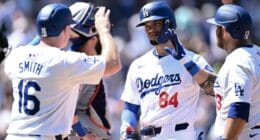You know the numbers and facts by now, I’m sure: the Dodgers are off to their worst start since 1958, which was their first season in Los Angeles. They just got swept by the worst team in baseball and they’ve add additional series losses to the San Diego Padres (16-26) and Miami Marlins (14-26). It’s bad, and there’s really no way around it.
And yet, as cliché as it sounds and as old as it’s getting to hear: it’s still early. The Dodgers enter the week eight games out of first place in the National League West and seven games out of the second Wild Card spot.
There are still 121 games remaining this year.
With all of that in mind, let’s look at how the Dodgers got here by handing out our grades for the first quarter of the 2018 season.
Starting Pitching: B+
You probably weren’t expecting that favorable of a grade. But consider this: despite the dreadful team start, Dodger starters are currently seventh in all of baseball in WAR, and third in the NL.
This is due in part to their 3.52 ERA (sixth-best in baseball), 9.87 strikeouts per nine innings (third overall) and 2.62 walks per nine (fifth-best). In fact, the group is posting these numbers despite allowing the seventh-highest BABIP in the league (.304).
The truth is, the starting pitching has been really good and everything else has been really, really bad. Leading the charge among starters has been Alex Wood, whose 2.54 FIP ranks sixth in all of baseball. Behind Wood, the Dodgers have gotten solid contributions from Clayton Kershaw (2.86 ERA despite what seems like a ‘down year’), Walker Buehler (1.64 ERA) and Hyun-Jin Ryu (who had a 2.12 ERA before going down with an injury).
In fact, even Kenta Maeda — whose 4.89 ERA isn’t pretty — has been the recipient of some pretty dreadful luck (.375 BABIP) and who projects to be much better moving forward.
On the whole, this is a group who has done their job. Their performance has probably been picked apart more than usual simply because of the overall struggles, but in isolation there’s nothing to complain about here.
Relief Pitching: F
Of all the bullpens in baseball, the Dodgers’ ranks 27th in WAR thanks to a 4.57 ERA in 155.2 innings. Yes, they’re seventh in innings pitched, but that’s no excuse for a group that has long been expected to be a strength.
As noted in this space last week, the bullpen is coming off back-to-back seasons as one of the top-five groups in all of baseball, but the losses of Brandon Morrow, Tony Watson and Luis Avilan are looming large.
From the outside, it seems like the Dodgers front office believes they can patch together a bullpen from spare parts and cast-offs. And in years past, they have. But this season might be the year that plan falls apart.
So far they’ve gotten nothing from Tom Koehler (who is injured), worse than nothing from Scott Alexander (-0.2 WAR), J.T. Chargois (-0.1 WAR) and Daniel Hudson (-0.1 WAR).
Oh, and then there’s the Kenley Jansen experience: a 3.78 ERA (which seems low) and two blown saves in eight chances. Once the best closer in baseball, Jansen has looked far from it thus far (although he is starting to flash some signs). Until that returns, this group is in trouble.
As it stands, no team in baseball has more blown saves than the Dodgers this season, no team has allowed more home runs and just four teams have walked more batters. Not exactly a recipe for success.
Lineup: D+
It’s funny how numbers can tell you just about anything you want them to. When it comes to WAR, the Dodger hitters are about average, ranking 15th. When it comes to home runs, they’re 25th. When it comes to on-base percentage, the Dodgers are 18th (not terrible), but when it comes to slugging percentage, they’re 24th.
Truth be told, I believe this is the group that has probably gotten the most unfair scrutiny. While expected to be far better than ‘average,’ the reality is they aren’t the reason this team is losing two out of every three baseball games.
Throw in the obvious: they’ve been without arguably their best hitter all season (Justin Turner) and the player second on that list won’t be back for the remainder of the season (Corey Seager), and it’s hard to get too frustrated.
Sure, the Dodgers have gotten lucky with the production of Matt Kemp (who they had no intention of counting on) and Chase Utley (who they almost didn’t re-sign), but that pales in comparison to the loss of Turner and Seager.
The answers here are pretty obvious, and Dodgers manager Dave Roberts even said so last week. This team relies on hitting home runs and drawing walks, and they simply haven’t been great at either this season. As I said earlier, the Dodgers are one of the five worst teams in baseball when it comes to hitting homers right now.
Coaching: D-
I hate to pile on to what has clearly been a tough year for Roberts, and I struggle to place too much blame on someone who doesn’t get a chance to throw or hit a baseball, but situations like this are exactly what you pay a manager to get you out of.
This group plays like a group who lack focus and motivation — the two things the manager is expected to influence most. Add into that the poor performance of the bullpen — the manager’s greatest tool — and it’s tough to be pleased with how things have gone for Roberts so far.
All that said, Roberts did get a vote of confidence from Friedman this week (despite the fact that his contract is not guaranteed beyond this season), and he is just a few months removed from getting this team to the cusp of a championship.
This grade is less a reflection on, ‘Is Dave Roberts a good manager?’ and more focused on, ‘has Dave Roberts done his job this season?’ I think the answer to the first question is yes, but the answer to the second has clearly been no.
The good news, of course, is that there’s plenty of time left for things to turn around. Perhaps no franchise knows better than the Dodgers how quickly a team can get hot (or cold) and change the complexion of their season.
The question for Roberts is whether or not he can convince this group that it’s possible.





